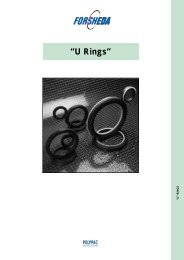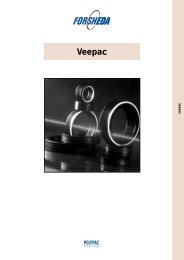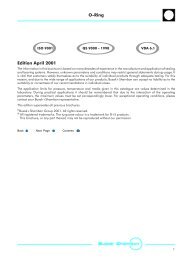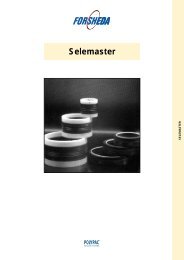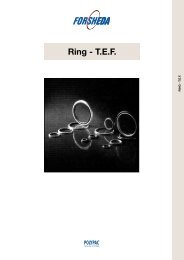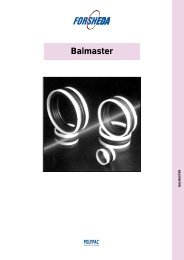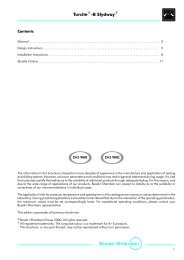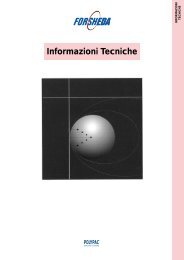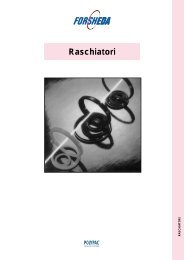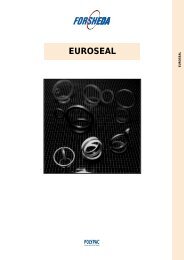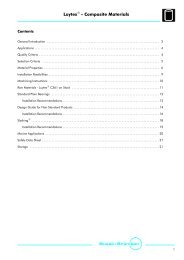Rotary Seals - Dilanda.it
Rotary Seals - Dilanda.it
Rotary Seals - Dilanda.it
You also want an ePaper? Increase the reach of your titles
YUMPU automatically turns print PDFs into web optimized ePapers that Google loves.
V—Ring<br />
n Installation<br />
Axial support<br />
When used to retain oil and grease, an axial support for<br />
the V—Ring is always required. For applications w<strong>it</strong>h a lower<br />
degree of stretch than recommended in the dimension<br />
tables (e.g. for ease of assembly) or w<strong>it</strong>h a shaft speed<br />
exceeding 6-8 m/s (depending on the rubber compound<br />
selected) an axial support is also necessary.<br />
An axial support can ensure that the correct installation<br />
width relative to the counter-face is maintained for blind<br />
assemblies.<br />
The V—Ring must always be supported over <strong>it</strong>s entire base.<br />
The axial support should be designed in accordance w<strong>it</strong>h<br />
Figure 56. The dimensions A, c, d 1 ,d 3 and B 1 are shown in<br />
the dimension tables.<br />
Calculation of the axial support diameter d 5 is as follows;<br />
V—Ring type<br />
A, S d 1 + 0.5 x c<br />
L, LX d 1 +3mm<br />
RM, RME<br />
d 1 +10mm<br />
AX<br />
d 1 +9mm<br />
Diameter d5<br />
Radial retention<br />
When the V—Ring is f<strong>it</strong>ted on the shaft, the body of the<br />
V—Ring is subject to a centrifugal force and tends to move<br />
or even lift off from the shaft at a certain speed.<br />
At shaft speeds over 10-12 m/s, depending on the V—Ring<br />
material, the V—Ring in general requires radial retention.<br />
The speed when radial retention is required is also<br />
dependent on the degree of stretch of the V—Ring.<br />
V—Rings larger than 2000 mm should always be f<strong>it</strong>ted<br />
w<strong>it</strong>h radial retention, irrespective of the operating speed.<br />
The radial retention can be designed as a recess, in which<br />
the V—Ring body f<strong>it</strong>s, or consist of a number of separate<br />
clamping segments. Please contact your local B+S company<br />
for further guidance.<br />
The clamping band type A or RM are other useful<br />
alternatives. See page 149.<br />
Stationary assembly<br />
In cases where the peripheral speed of the shaft exceeds<br />
10-12 m/s an alternative method to radial clamping is to<br />
mount the V—Ring on a stationary component in the un<strong>it</strong>.<br />
The contact pressure of the lip will remain constant, as<br />
there will be no centrifugal force acting upon the lip.<br />
In comparison to a rotating V—Ring, friction and power loss<br />
will be higher resulting in somewhat shorter service life. In<br />
order to compensate for this the following steps should be<br />
taken:<br />
Counter-face surface finish:<br />
machine to max. 0.8 μm Ra<br />
d 2<br />
d 1<br />
c<br />
A<br />
1.1 A<br />
B 1<br />
d 5<br />
d 3<br />
V—Ring stretch:<br />
maximum 4-6%<br />
Axial interference:<br />
keep to the minimum requirements for<br />
compensation of the axial movement w<strong>it</strong>hin the<br />
assembly.<br />
At higher peripheral speed adequate lubrication and heat<br />
transfer from the counter-face are required.<br />
Figure 56<br />
Axial support<br />
Torque<br />
The torque, and consequently the power loss due to the<br />
friction of the seal, is often of such a magn<strong>it</strong>ude that <strong>it</strong><br />
should be taken into consideration when deciding seal<br />
type. This applies particularly in the case of small electrical<br />
motors, conveyor rollers or any un<strong>it</strong> where low friction is an<br />
important requirement.<br />
148<br />
Latest information available at www.busakshamban.com<br />
Ed<strong>it</strong>ion April 2006



